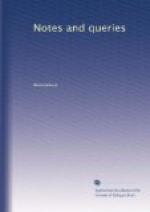As regards the term cipher or zero (which are so obviously the same as to need no remark), it is admitted on all hands to be derived from one or other of the Semitic languages, the Hebrew or the Arabic. It is customery with the mathematical historians to refer it to the Arabic, they being in general more conversant with it than with the Hebrew. The Arabic being a smaller hand than the Hebrew, a dot was used instead of the circle for marking the “place” at which the hiatus of any “denomination” occurred. If we obtained our cipher from this, it would be made hollow (a mere ceinture, girdle, or ring) to save the trouble of making a dot sufficiently large to correspond in magnitude with our other numerals as we write them. Either is alike possible—probability must be sought, for either over the other, from a slightly different source.
The root-words in Hebrew and in Arabic are precisely the same (ts-ph-r), though in the two {368} languages, and at different ages of the same language, they might have been vowelised differently. In some shape or other, this name is used in all countries that have derived their arithmetic from mediaeval Italy, or from the Saracens. It is with some cipher, with others chiffre, and with all zero. The word is certainly no more Italian than it is French or English. Be it remembered, too, that ezor (quoted at p. 268.), as a girdle, is radically the same word, somewhat mutilated. The cardinal meaning of the word (denuded of the conventional accretions of signification, which peculiar applications of it adds to the cardinal meaning) appears to be emptiness, hollowness, nothingness. It may be further remarked, that in the fine Chartres MS. of Boetius, described by Chasles, the 0 is called sipos:—the same name, he remarks, that Graves found in use in the East. The modern Turks call the 0, tsifra.
It is curious enough that in all languages, the term ciphering is popularly used to denote all arithmetical operations whatever. Our schoolboys do their “ciphering,” and write carefully in their “ciphering-books.” This all seems to point to the art of dispensing with the use of the abacus or counting table.
T.S.D.
Shooter’s Hill, March 5.
[1] The best account, because the most consistent and intelligible, of the Greek arithmetic, is that by Delambre, affixed to Peyraud’s edition of Archimedes.
[2] At a period of leisure I may be tempted to send you a few extracts, somewhat curious, from some of the papers of Mr. Strachey in my possession.




